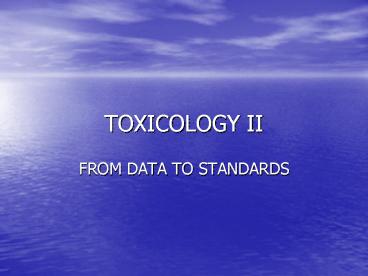TOXICOLOGY II - PowerPoint PPT Presentation
1 / 18
Title:
TOXICOLOGY II
Description:
TOXICOLOGY II. FROM DATA TO STANDARDS. FROM DATA TO STANDARDS. 2 ... Standards are to protect people from chronic health effects. FROM DATA TO STANDARDS ... – PowerPoint PPT presentation
Number of Views:57
Avg rating:3.0/5.0
Title: TOXICOLOGY II
1
TOXICOLOGY II
- FROM DATA TO STANDARDS
2
Setting Drinking Water Standards
- The federal Safe Drinking Water Act requires the
Environmental Protection Agency (EPA) to regulate
drinking water to protect public health.
3
Setting Drinking Water Standards
- Acute poisoning is not a worry with drinking
water. - Standards are to protect people from chronic
health effects.
4
Setting Drinking Water Standards
- EPA has a national standard for each drinking
water contaminant. (80 so far) - Called Maximum Contaminant Level
5
Setting Drinking Water Standards
- Maximum Contaminant Level is
- A Estimate of the Max. Concentration an average
person could drink every day without health
problems. - Average adult (70 kg) male who drinks 2L of water
a day for 70 years.
6
Setting Drinking Water Standards
- Maximum Contaminant Level is
- Developed for animal studies
- Lower standards are set if one group of humans
are especially sensitive to a contaminant. - Topic Drinking Water Standards
- Go to www.sciLINKS.org
- Code ATR04
7
Setting Drinking Water Standards Uncertainty
Factor
- Because animals NOT humans are used there is a
lot of uncertainty. - An Uncertainty Factor is used to correct for
differences between experimental animals and
humans. - Uncertainty Factors range from 10 to 1000
- 10 is used if good data on humans is available,
if not higher numbers are used.
8
Setting Drinking Water StandardsUncertainty
Factor
- Example
- 200mg/kg 100 2mg/kg
- safe dose uncertainty adjusted safe
. in mice factor dose in humans
9
Questions Used in Converting Animal Data to Human
Drinking Water Standards I
- TOPIC Human Characteristics
- QUESTIONS
- How much does the average person weigh?
- How much water does the average person drink?
- How long does the average person live?
10
Questions Used in Converting Animal Data to Human
Drinking Water Standards II
- TOPIC Chemical Characteristics
- QUESTIONS
- How much of this chemical are humans exposed to
through other sources? - Is this chemical broken down quickly or does it
build up in the human body? - Is it suspected to cause cancer?
11
Questions Used in Converting Animal Data to Human
Drinking Water Standards II (Continued)
- Do males and females react differently to the
chemical? - Does a baby, elderly person or a person with a
weakened immune system react differently than an
average person?
12
Questions Used in Converting Animal Data to Human
Drinking Water Standards III
- TOPIC Data Characteristics
- QUESTIONS
- What uncertainty factors should be used when
switching between the chemicals effects in
animals and its estimated effects in humans?
13
FROM DATA TO STANDARDS
- EXAMPLE Say 200mg/kg/day of compound A is the
highest dose that causes no chronic health
problems in rats.
14
FROM DATA TO STANDARDS STEP 1
- Apply the right Uncertainty Factor.
- For example use 100 if we have good data.
- 200mg/kg 100 2mg/kg
- safe dose uncertainty adjusted safe
. in mice factor dose in
humans
15
FROM DATA TO STANDARDS STEP 2
- Convert the number into the amount for humans
instead of rats. EPA uses 70 kg as avg. weight
of humans. - 2mg/kg/day 70kg 140 mg/day .adjusted
weight of comparable dose
safe dose avg. human in
humans .
Male adult
16
FROM DATA TO STANDARDS STEP 3
- Ask if all of this 140 mg/day were consumed in
drinking water what would the concentration be?
EPA uses 2L of water/day. - 140 mg/day 2 L/day 70mg/L
17
FROM DATA TO STANDARDS STEP 4
- We get contaminants from lots of places besides
water, so EPA figures only 20 of any daily
consumption of a compound comes from water. - 70 mg/L 0.20 14mg/L
18
From Data to Standards
- Carcinogens the Maximum Contaminant Level is the
lowest concentration that is measurable. - Remember Nothing is absolutely safe










![READ [PDF] A Textbook of Modern Toxicology PowerPoint PPT Presentation](https://s3.amazonaws.com/images.powershow.com/10075008.th0.jpg?_=20240709065)




















